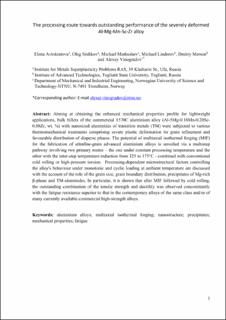The processing route towards outstanding performance of the severely deformed Al–Mg–Mn-Sc-Zr alloy
Avtokratova, E. V.; Sitdikov, Oleg; Markushev, Mikhail; Linderov, Mikhail; Merson, Dmitry; Vinogradov, Alexey
Journal article
Submitted version
Permanent lenke
https://hdl.handle.net/11250/3002661Utgivelsesdato
2021Metadata
Vis full innførselSamlinger
Sammendrag
Aiming at obtaining the enhanced mechanical properties profile for lightweight applications, bulk billets of the commercial 1570C aluminium alloy (Al–5Mg-0.18Mn-0.20Sc-0.08Zr, wt. %) with nanosized aluminides of transition metals (TM) were subjected to various thermomechanical treatments comprising severe plastic deformation for grain refinement and favourable distribution of disperse phases. The potential of multiaxial isothermal forging (MIF) for the fabrication of ultrafine-grain advanced aluminium alloys is unveiled via a multistep pathway involving two primary routes – the one under constant processing temperature and the other with the inter-step temperature reduction from 325 to 175 °C - combined with conventional cold rolling or high-pressure torsion. Processing-dependent microstructural factors controlling the alloy's behaviour under monotonic and cyclic loading at ambient temperature are discussed with the account of the role of the grain size, grain boundary distribution, precipitates of Mg-rich β-phase and TM-aluminides. In particular, it is shown that after MIF followed by cold rolling, the outstanding combination of the tensile strength and ductility was observed concomitantly with the fatigue resistance superior to that in the contemporary alloys of the same class and/or of many currently available commercial high-strength alloys.
